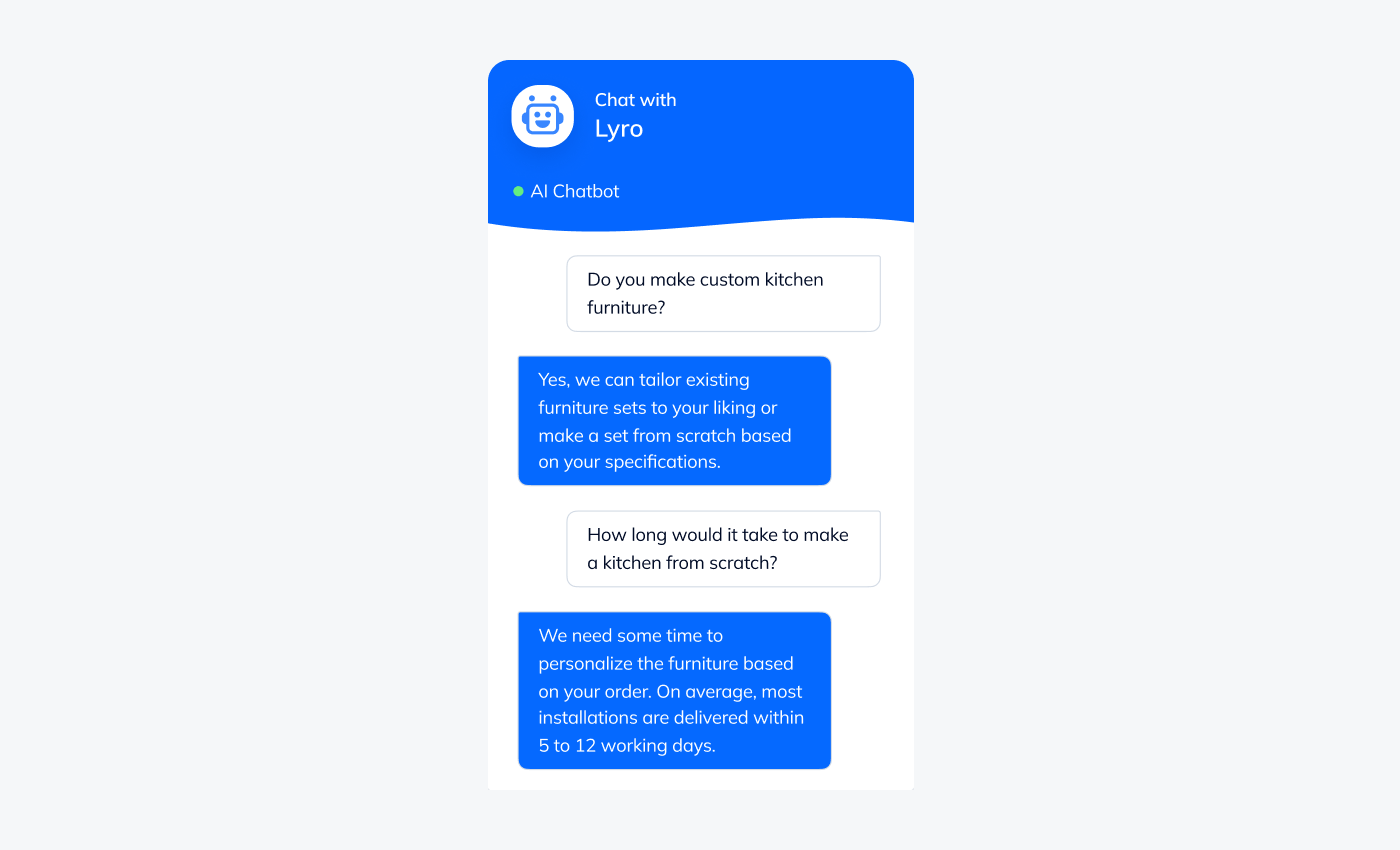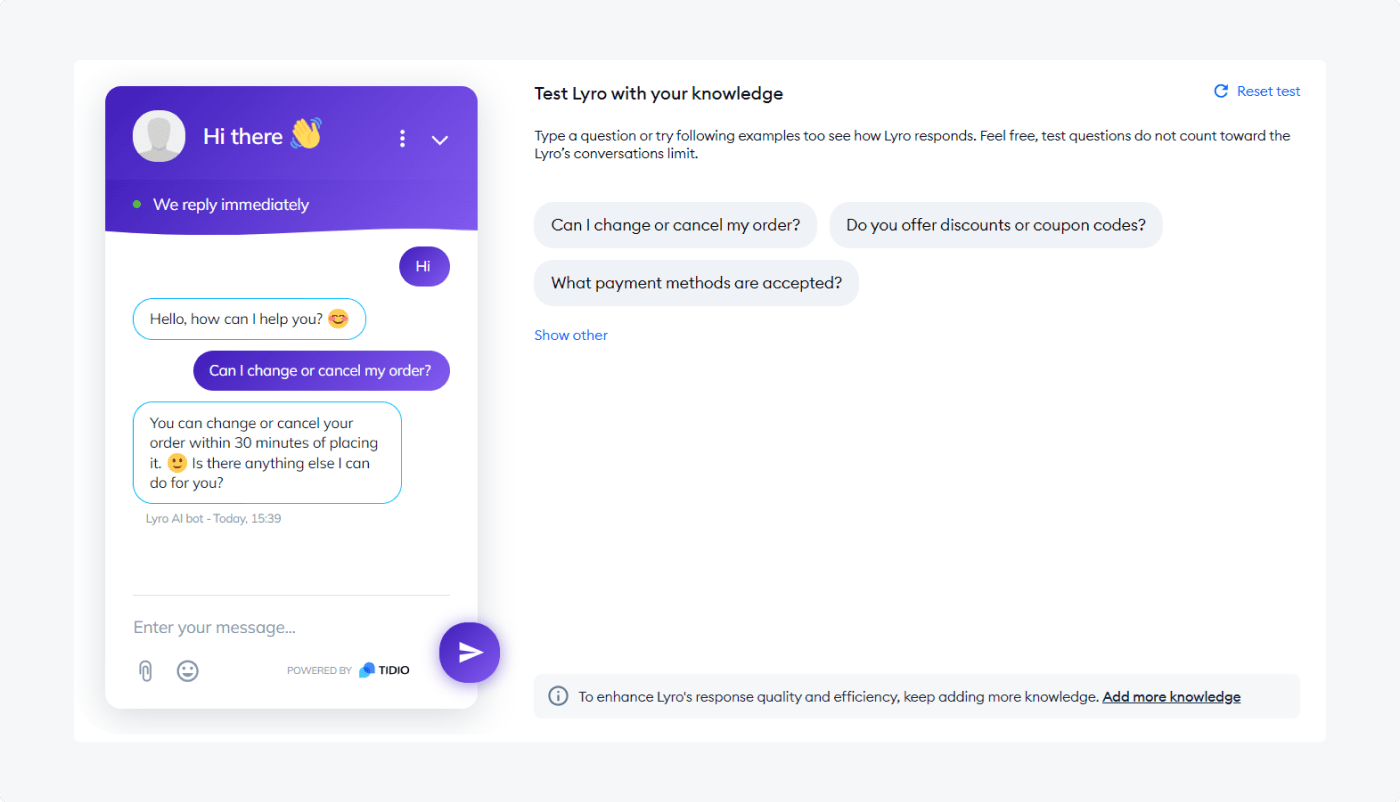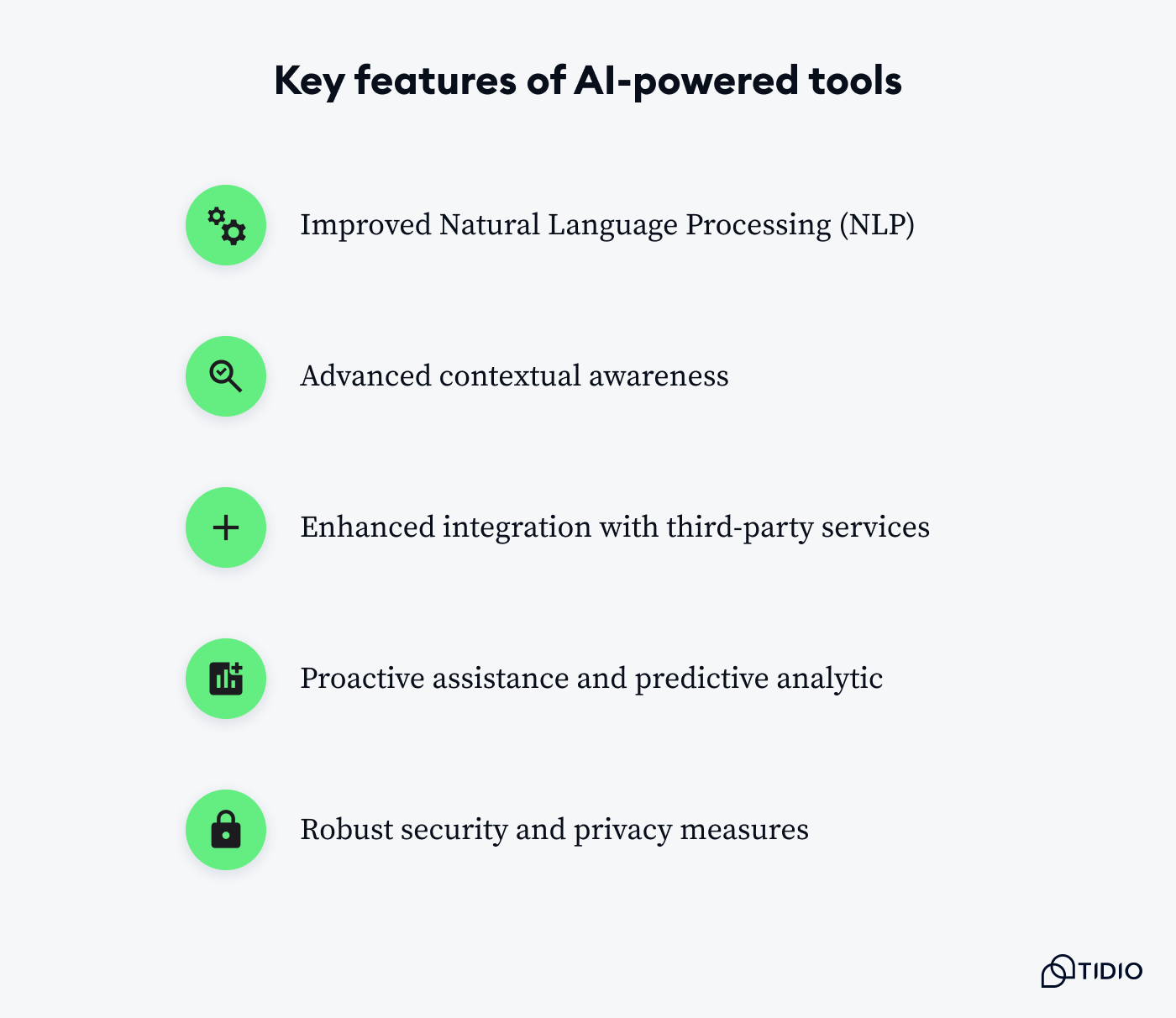In this era of generative AI and quick technological advancements, chatbots and AI virtual assistants have emerged as essential tools for both businesses and individuals.
But while they might appear similar at first glance, their capabilities and applications differ significantly.
So—
How to distinguish between the two? And which technology is more suitable for your needs?
Don’t worry—we’ve got you covered.
We’ll explore the definitions, functionalities, and key differences between a chatbot vs. virtual assistant, helping you decide on your ideal pick.
Take customer support to another level with affordable AI chatbot
First things first—
How do AI chatbots work?
A chatbot is a software application designed to engage in conversation with users via text or voice interfaces. These interactions are often aimed at answering questions, completing tasks, or providing customer support. Chatbots are commonly found on websites, social media platforms, and messaging apps, where they assist users with various inquiries.
Now—
It’s important to mention that there are two main types of chatbots: rule-based and AI chatbots:
- Rule-based bots operate through a combination of predefined rules and decision trees. When a user inputs a query, the chatbot scans for keywords or phrases and matches them to its rule set, providing a response.
- AI chatbots leverage ML algorithms and NLP to analyze the text or voice input. These chatbots study the intent behind the user’s message to generate an appropriate and often more sophisticated response. Over time, they use data from previous interactions to improve their accuracy and effectiveness in addressing user needs.
A classic example of a chatbot in action would be the automated response system on a company’s customer service webpage which helps users resolve basic issues or find information.
On the other hand, a more advanced chatbot example is Tidio’s Lyro, acts as an intelligent virtual agent capable of providing more personalized support and answers to FAQs in a human-like manner.

Offer personalized customer service using AI chatbots
Read more: Find out how to use Tidio’s Lyro AI chatbot to streamline your support processes. Also, check out how Tidio’s CS team enhanced support automation using Lyro.
With that out of the way, let’s address the following—
What is an AI virtual assistant?
AI virtual assistants are more complex computer programs designed to perform tasks or services for an individual based on voice commands or text inputs. AI-powered intelligent virtual assistants utilize advanced technologies, including natural language processing (NLP), natural language understanding (NLU), and machine learning (ML), to understand and interpret user commands.
They are capable of analyzing not only the words but also the context and intent behind the commands. After interpreting the input, the assistant processes the information, interacts with various services or databases if needed, and delivers the requested output in a conversational manner.
A well-known example of an AI-based virtual assistant is Apple’s Siri, which can assist users in performing a wide range of activities and more complex tasks. These include sending texts, setting alarms, providing weather updates, and even controlling smart home appliances with voice commands. Other popular examples include Amazon’s Alexa, Microsoft Cortana, and Google Assistant, both of which offer similar functionalities.

Read more: Find out all you need to know about NLP chatbots.
Now, onto the part you came here for—
What is the difference between a virtual assistant and a chatbot?
While both virtual assistants and chatbots aim to assist in smooth customer interactions through conversational interfaces, they cater to different needs and complexities. Virtual assistants are designed to perform a broad range of tasks, often adapting to the user’s preferences over time.
On the other hand—
Chatbots are typically focused on specific tasks or queries and vary in capability from simple rule-based systems to more advanced AI-driven models.
Understanding their core differences is essential to select the right tool for your needs. Let’s check them out:
| Feature | Chatbot | AI Virtual Assistant |
|---|---|---|
| Complexity of interaction | Basic to moderate | Highly advanced, performs diverse tasks |
| Task range | Limited to specific tasks | Capable of handling multifaceted activities |
| Adaptability | Low to medium | High—learns and adapts to user preferences |
| Use case | Customer service, simple queries | Personal assistance, smart home control |
| Learning capability | Limited to moderate | Advanced |
| Channels used | Websites, social media platforms and apps | Smartphones, smart speakers, IoT devices |
Let’s go in more depth and check each category one by one.
Complexity of interaction
Chatbots generally engage customers in straightforward, task-specific conversations. They excel at handling predefined or predictable queries, making them ideal for addressing common customer service questions or guiding users through basic tasks. However, they often struggle with more complex or ambiguous requests.
On the other hand, AI virtual assistants deliver highly personalized and advanced conversational interactions. They can understand nuances and maintain context over extended exchanges, handling multistep tasks, and providing more human-like conversations. This makes them suitable for people seeking comprehensive assistance across various contexts.
Read more: Find out more about conversational AI and how it works.
Task range
When it comes to task range, chatbots focus on a narrow set of tasks such as answering FAQs, processing customer service inquiries, or providing information. They are often deployed to manage specific functions within a website or application, helping to streamline customer interactions for common issues.
Conversely, AI virtual assistants for customer service are capable of managing a wide array of tasks. They can schedule events, set reminders, perform internet searches, control smart devices, and offer comprehensive assistance. This versatility makes them valuable both for personal and professional use, significantly enhancing productivity and convenience.
Read more: Find out the key differences between chatbots and conversational AI.
Adaptability
Chatbots offer rigid to moderately flexible responses, often based on predefined rules or limited machine learning capabilities. While they handle specific queries efficiently, they lack the ability to significantly adapt or improve their responses based on client interactions in real time.
In contrast, AI virtual assistants exhibit high adaptability. They continuously learn from customer interactions, refining their responses to provide more accurate and personalized assistance. Thanks to this, they can better understand user preferences and anticipate needs, delivering a more tailored customer experience over time.
Read more: Here’s all you need to know about virtual shopping assistants.
Use cases
Chatbots are best suited for specific use cases such as customer support, handling simple or repetitive queries, and providing instant information. They are commonly found in industries like ecommerce, banking, and telecom, where they help reduce human workload and improve customer response times.
AI virtual assistants, however, can act as personal assistants for various daily activities, ranging from professional productivity tasks to managing a smart home ecosystem. Their applications include setting appointments, sending messages, playing music, and providing weather updates, making them very useful tools for enhancing everyday life.
Read more: Explore the best chatbot use cases for customer service. Also, make sure to check out top ecommerce chatbots for your site.
Learning capabilities
In terms of learning ability, chatbots may encompass basic capabilities or predefined response patterns. While their effectiveness improves gradually through updates, they do not adapt significantly in real time based on user interactions.
AI virtual assistants, on the other hand, utilize advanced machine learning and predictive algorithms. They continuously learn from interactions and predict customer needs, offering proactive service. The ongoing learning process enhances their ability to provide more relevant and timely responses, ultimately improving customer satisfaction.
Operating channels
Finally, the channels used by chatbots and AI virtual assistants differ significantly. Chatbots are typically deployed on websites, social media platforms, and messaging apps, where they assist with customer service or simple customer queries. These channels are ideal for reaching a broad audience and providing instant support, making chatbots a popular choice for businesses.
In contrast, AI virtual assistants are found on smartphones, smart speakers, and other IoT (Internet of Things) devices. Their presence across multiple devices ensures they are always available to help, providing seamless assistance with daily activities and enhancing user convenience.
By understanding these distinctions, you can make a more informed decision regarding whether a chatbot or an AI virtual assistant is the right tool for your specific requirements, whether they be for business or personal use.
Read more: Learn all about Instagram chatbots and how to make one for your needs. Also, while you’re at it, be sure to explore the topic of Facebook chatbots and WhatsApp chatbots.
Chatbot vs. virtual assistant: which one to go for?
When deciding between a chatbot and an AI virtual assistant, it’s essential to consider the specific needs and context of the application in question. Both tools have unique strengths and can be incredibly useful in different scenarios.
Let’s take a closer look.
Functionality
Chatbots are designed for handling straightforward queries or repetitive tasks. They excel in providing quick answers to common questions, guiding clients through processes, and managing simple tasks. By installing a chatbot on your website, social media platform, or messaging app, you can offer instant support to your customers, reducing wait times and improving overall customer satisfaction. In fact, according to research, AI software boosts CSAT scores by an average of 12%!
In addition, there are AI chatbots that can be quite useful in acting as AI knowledge base agent.
For example—
Tidio’s Lyro AI can pull knowledge from predefined question-answer pairs and handle all related queries in a natural, human-like manner. You can choose from adding knowledge to Lyro manually, or have it pull information from your website’s pages automatically.

On the other hand—
AI virtual assistants are designed for more complex support environments. They’re capable of managing a wide range of activities such as scheduling meetings and setting reminders. These assistants adapt to users’ preferences over time, providing personalized and contextually aware assistance. Their ability to predict user needs and offer proactive help makes them excellent for comprehensive support.
Final thoughts:
Chatbots are great to use for more straightforward tasks as they offer efficiency and quick responses. For more complex and personalized assistance, AI virtual assistants will provide more comprehensive support and continuous adaptation.
Industry
Chatbots are particularly beneficial for industries like ecommerce, banking, and telecommunications, where customer inquiries often follow predictable patterns and can be resolved through predefined responses.
For example, in ecommerce, chatbots can handle order tracking, product inquiries, and simple troubleshooting, allowing human agents to focus on more complex issues. In banking, finance chatbots can assist with account inquiries, transaction details, and basic financial advice. Finally, telecommunications companies can use chatbots for troubleshooting common issues, account management, and service inquiries.
On the other hand, businesses can benefit from AI virtual assistants like Siri, Alexa, or Google Assistant by integrating them into their workflows to enhance productivity and streamline operations. In corporate settings, these assistants can manage schedules, set reminders, and control conference systems, significantly improving operational efficiency. Moreover, these smart virtual helpers shine in scenarios where continuous learning and adaptation are crucial.
Final thoughts:
Industries dealing with predictable customer interactions can greatly benefit from chatbots, while those requiring continuous learning and complex support scenarios will find AI virtual assistants invaluable.
Volume of interactions
Chatbots are particularly effective for handling large volumes of straightforward queries or repetitive tasks efficiently. Their ability to provide instant support meets the preference of 83% of consumers who prefer to receive assistance right upon contact.
So, by implementing chatbots, businesses can ensure that straightforward inquiries are handled quickly and effectively, while human agents are free to focus on more complex and nuanced customer issues.
AI virtual assistants can also handle a significant volume of interactions, but they are distinct in their capacity to manage a variety of more complex tasks. They are well-suited for environments where interactions require multitasking and contextual understanding. Virtual assistants can juggle multiple responsibilities while offering personalized assistance based on user preferences.
Final thoughts:
For businesses managing numerous basic and repetitive queries, chatbots provide a scalable solution to deliver swift, efficient responses. On the other hand, AI virtual assistants offer robust support in environments that demand both high interaction volumes and the ability to perform complex, multitasking functions.
The future of chatbots and virtual assistants
As AI technology advances, both chatbots and AI virtual assistants are set to become even more integrated into our daily lives and business processes. In fact, Gartner predicts that by the year 2025, 80% of client interactions will include the use of AI.
Here are some key features of AI-powered tools that will be especially beneficial in the future:

- Improved Natural Language Processing (NLP)—enhanced ability to understand and process human language will result in better handling of slang, dialects, and complex sentence structures, making interactions more human-like
- Advanced contextual awareness—increased capability to retain context over long conversations will enable AI to understand the user’s environment and previous interactions for more personalized responses
- Enhanced integration with third-party services—broader integration with various third-party applications, platforms, and devices will provide seamless connections between different systems and allow for more unified user experiences.
- Proactive assistance and predictive analytics—the ability to predict user needs and offer proactive suggestions and reminders will allow AI to anticipate future actions and streamline tasks
- Robust security and privacy measures—improved security protocols to protect user data and ensure privacy can provide users with greater confidence in using these technologies
All in all, the future of chatbots and virtual assistants is incredibly promising. These AI-powered tools are set to revolutionize how we interact with technology, making our lives more convenient, efficient, and personalized.
Chatbots vs. virtual assistants: key takeaway
Both chatbots and AI virtual assistants offer significant advantages depending on the context. Chatbots are ideal for handling specific, repetitive tasks and providing immediate customer support, making them perfect for businesses with well-defined queries. In contrast, AI virtual assistants are more versatile and adaptive, suitable for users who require comprehensive, personalized assistance across a range of activities.
As technology evolves, the integration of advanced AI features like improved natural language processing, contextual awareness, and proactive assistance will continue to blur the lines between these tools, making them even more indispensable.
Ultimately, the choice between a chatbot and an AI virtual assistant depends on your specific needs and the complexity of the tasks you plan to streamline.
Offer personalized customer service using AI chatbots

